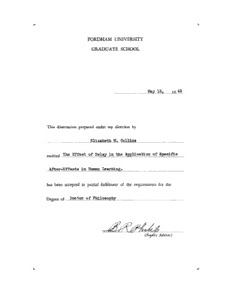
The Effect of Delay in the Application of Specific After-Effects in Human Learning PDF
Preview The Effect of Delay in the Application of Specific After-Effects in Human Learning
r FORDHAM UNIVERSITY GRADUATE SCHOOL May 15^ 19. A?. This dissertation prepared under my direction by E l i z a b e t h . .................... entitled -^e Effect of Delay in the Application of Specific After-Effects in has been accepted in partial fulfilment of the requirements for the Degree of Doctor of Philosophy (Faulty Adviser) L -I THE EFFECT OF DELAY IN THE APPLICATION OF SPECIFIC AFTER-EFFECTS IN HOMAN LEARNING BY ELIZABETH MARY COLLINS A*B., Manhattan®!.lie College, *38 M.A., Fordham University, *39 DISSERTATION SUBMITTED IN PARTIAL FULFILLMENT OF THE REQUIREMENTS FOR THE DEGREE OF DOCTOR OF PHILOSOPHY IN THE DEPARTMENT OF PSYCHOLOGY AT FORDHAM UNIVERSITY NEW YORK 1942 ProQuest Number: 10992521 All rights reserved INFORMATION TO ALL USERS The quality of this reproduction is dependent upon the quality of the copy submitted. In the unlikely event that the author did not send a complete manuscript and there are missing pages, these will be noted. Also, if material had to be removed, a note will indicate the deletion. uest ProQuest 10992521 Published by ProQuest LLC(2018). Copyright of the Dissertation is held by the Author. All rights reserved. This work is protected against unauthorized copying under Title 17, United States Code Microform Edition © ProQuest LLC. ProQuest LLC. 789 East Eisenhower Parkway P.O. Box 1346 Ann Arbor, Ml 48106- 1346 iii r “i TABLE OF CONTENTS Chapter Page LIST OF TABLES............................................. iv LIST OF FIGURES............................................ v I. INTRODUCTION........................................... 1 II. REVIEW OF LITERATURE................................... 4 III. CONSTRUCTION AND ADMINISTRATION........................ 11 Selection of Materials Apparatus Rotation Scheme Procedure Preliminary Experiment Main Experiment IV. TREATMENT OF DATA FROM MAIN EXPERIMENT.................. 26 Analysis of Results by First Method Analysis of Results by Second Method V. COMPARISON OF GRADIENTS................................ 40 VI. THEORETICAL IMPLICATIONS............................... 46 VII. SUMMARY AND CONCLUSIONS................................ 49 Conclusions APPENDIX A.................................... *........... 53 Scoring Blank APPENDIX B................................................. 55 Machine Procedures BIBLIOGRAPHY............................................... 61 L. -J iv r -i LIST OF TABLES Table Page I. After-effects in Stephens’ Experiment.................. 4 II. Summary of Zaganczyk’s Study........................... 5 III. Distribution of Subjects (Forlano)..................... 10 IV. Mean Scores for "Unfilled” Interval.................... 27 V. Mean Scores for "Filled" Interval...................... 27 VI. Standard Deviation of Scores........................... 29 VII. Critical Ratios of Differences of Test Scores and Initial Scores......................................... 29 VIII. Critical Ratios of Differences between Total Scores for Various Trials......................................... 30 IX. Critical Ratios of Differences between Scores on Test According to Delay..................................... 33 X. Differences of Test Scores of "Unfilled" and "Filled Groups .......................................... 33 XI. Analysis of Variance "Unfilled" Intervals............. 34 XII. Analysis of Variance "Filled" Intervals............... 34 XIII. Percentage of Repetition of Responses for "Unfilled" Interval............................................... 38 XIV. Percentage of Repetition of Responses for "Filled" Interval............................................... 38 XV. Serial Position Gradient for "Unfilled" Interval...... 41 XVI. Serial Position Gradient for "Filled" Interval......... 41 L —s V. r "» LIST OF FIGURES Figure Page 1. Series A— Learning Material............................ 13 2. Series B— Learning Material............................. 14 3. Rotation Scheme................ 17 4. Presentation Order of Delay Intervals.................. 18 5. Average Total Number Correct Preliminary Group......... 23 6. Average Number Correct for Each Delay Period Preliminary Group....................................... 24 7. Average Total Number Correct........................... 28 8. Average Number Correct for Each Delay Period "Unfilled" Interval.................................... 31 9. Average Number Correct for Each Delay Period "Filled" Interval...................................... 32 10. Serial Position for Each Trial......................... 42 11. Serial Position for Combined Trials..................... 43 L “1 r "I ACKNOWLEDGEMENTS To Dr. R. T. Rock Jr., who first aroused ray interest in the field of learning and who initiated this research, and to Dr. B. R. Philip, who guided me through the difficulties of completing it, I offer my heartfelt thanks. To each and every one of the many who contributed to the carrying out of this study, I express my sincere appreciation and gratitude. r "i THE EFFECT OF DELAY IN THE APPLICATION OF SPECIFIC AFTER-EFFECTS IN HOMAN LEARNING L X r n CHAPTER I INTRODUCTION The aim of this research was to study the relative effect of immediate and of delayed application of specific after-effects in human learning. Does a delay introduced between the response and the after effect facilitate, hinder or have no effect whatsoever on learning? Is human learning more or less efficient when the after-effect follows the response as closely as possible? Earlier studies of this problem have yielded contradictory results. A careful scrutiny of these investigations revealed the fact that there were several defects in the design of the experiments, which might have been responsible for the contradictory conclusions. The present study sought to eliminate the more serious errors of these earlier investigations and thus produce more conclusive evidence on this problem. It is not the purpose of this paper to raise controversial issues concerning the concepts employed. The writer realizes that much has been said and much still remains to be said concerning the law of effect as formulated by Edward L. Thorndike. The discussion, while of great interest, would add little understanding to the solution of the problem under consideration. The following explanations and definitions have been set down to clarify the terms used in the present discussion. The delay consisted of an interval interpolated between response and after-effect, varying from zero to thirty seconds, during which the subject looked at a light on the experimenterTs desk. This has been termed an "unfilled” interval^
